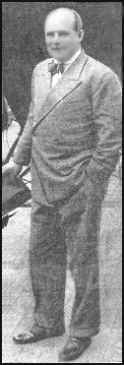

1896-1941 |
 |
 |
|
Photo Courtesy of Gaston Graf |
Photo Courtesy of Greg Powers |
|
|
|
Ernst Udet - Ace of the Iron Cross A translation largely based on the original text from his book "Mein Fliegerleben", published in 1935 This is a remarkable online resource and a fascinating story of his career. It contains many photographs which illustrate his life and is well worth your attention. To access the site, click on the title. "No. 6, Ernst Udet". Before you leave the site, I suggest that you browse it thoroughly. It is called "Koeniglich Preussische Jagdstaffel 2 "Boelcke" and is the entry point to a rich source of information on the period. It includes sections devoted to Aces, Aircraft, Artwork, Bibliography, Birth of Jasta 2, Books, Commanders of Jasta 2, Pilots of Jasta 2, Webmaster, and much more. |
|
You will find this to be a very useful resource for information on the period, including a comprehensive section on the air war. To access the site, click on the title. "Ernst Udet +aviation, you will find some 441 links. |
|
|
|
|
|
|
|
General Who Built Up german Air Force Dies Testing New Type of Weapon. New York Times, November 18, 1941 Collection of Greg Powers, 1-1-06 The official announcement said that Gen. Udet was hurt so gravely that he died before reaching a hospital. He was 45 years old. Adolf Hitler, who had named German Pursuit Squadron No. 3 for Gen. Udet in recognition of his achievements, ordered a State funeral in his honor. The time and place have not yet been decided on. Gen. Udet visited the United States in 1931 to participate in the national air races in Cleveland. While there he met Walter B. Wanamaker of Columbus, Ohio, whom he had pulled out of the wreckage of an American plane he shot down in 1918 when he was a major. ...................................................plane factory at Munich, transferring it to Augusburg in 1926. But this apparently was not a financial success, and after that venture he turned to stunt flying throughout Europe and America. Among his adventures were a series of flights over the Alps and !into Arctic regions to assist Leni Riefenstahl, famous German woman motion picture photographer, in filming those regions. His Arctic flights, in the course jof which he was once given up for lost after a four days' absence, were held of outstanding scientific value. Gen. Udet was received by French aviators at the Aero Club in Pans in 1928, the first German flyer so honored after the last world war. When Hermann Goering became Air Minister he advanced Gen. Udet, his world war comrade, to be Vice-Commodore in the German Air Sports Organization and later, upon the establishment of the German air force, to be colonel in it. He was rapidly promoted and was made colone! general, the rank next to a marshal, on July 19, 1940. On Ernst Udet probably more than on any other man fell the responsibility for keeping Germany abreast-and, if possible, ahead-of her enemies in the air. As chief engineer and chief of supply of the Nazi air force, it was he largely who shaped it as a weapon. Most famous of Germany's flying aces to survive the world wvar, he was assigned to the job of driving a small army of German airplane designers to their peak of achievement. The daredevil of world war days-credited with shooting down sixty-two planes-had flown in recent years only to test new types of warplane.When new planes appeared in combat in this war it was Gen. Udet who had ordered them and approved their design. He had a touch of genius both for motors and aircraft design. When he brought an exhibition plane to the United States in 1931 he "timed" the motor by touch for lack of instruments. |
|
If you have any information on this Early Flier, please contact me. E-mail to Ralph Cooper 

|